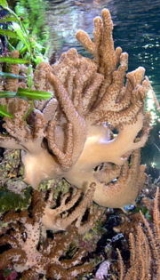
Alcyonacea
Encyclopedia
The Alcyonacea, or the soft corals are an order of coral
s which do not produce calcium carbonate
skeletons. Soft corals contain minute, spiny skeletal elements called sclerite
s. Aside from their scientific utility in species identification, sclerites give these corals some degree of support and give their flesh a spiky, grainy texture that deters predators. Recent findings suggest that colonies of sinularia are able to cement sclerites and consolidate them at their base into spiculite, thus making them reef builders. In the past soft coral were thought to be unable to lay new foundations for future corals.
Unlike stony corals, most soft corals thrive in nutrient-rich waters with less light intensity. Almost all utilize zooxanthella
as a major energy source. However, most will readily eat any free floating food, such as zooplankton, out of the water column. They are integral throughout the reef ecosystem and provide habitat for fish, snails, algae and a diversity of marine species.
Many soft corals are easily collected in the wild for the reef aquarium hobby, as small cuttings are less prone to infection or damage during shipping than stony corals. Nevertheless, home-grown specimens are more practical and help conserve wild reefs. Soft corals grow quickly in captivity and are easily divided into new individuals, and so those grown via aquaculture
are often hardier and less expensive than imported corals from the wild. The most common example of this is various species of Actinodiscus
, especially common red mushroom coral.
Related orders in the subclass Octocorallia include Sea pen
s, Sea fan
s, Sea whips, bamboo coral and xenias
.
Coral
Corals are marine animals in class Anthozoa of phylum Cnidaria typically living in compact colonies of many identical individual "polyps". The group includes the important reef builders that inhabit tropical oceans and secrete calcium carbonate to form a hard skeleton.A coral "head" is a colony of...
s which do not produce calcium carbonate
Calcium carbonate
Calcium carbonate is a chemical compound with the formula CaCO3. It is a common substance found in rocks in all parts of the world, and is the main component of shells of marine organisms, snails, coal balls, pearls, and eggshells. Calcium carbonate is the active ingredient in agricultural lime,...
skeletons. Soft corals contain minute, spiny skeletal elements called sclerite
Sclerite
A sclerite is a hardened body part. The term is used in various branches of biology for various structures including hardened portions of sponges, but it is most commonly used for the hardened portions of arthropod exoskeletons....
s. Aside from their scientific utility in species identification, sclerites give these corals some degree of support and give their flesh a spiky, grainy texture that deters predators. Recent findings suggest that colonies of sinularia are able to cement sclerites and consolidate them at their base into spiculite, thus making them reef builders. In the past soft coral were thought to be unable to lay new foundations for future corals.
Unlike stony corals, most soft corals thrive in nutrient-rich waters with less light intensity. Almost all utilize zooxanthella
Zooxanthella
Zooxanthellae are flagellate protozoa that are golden-brown intracellular endosymbionts of various marine animals and protozoa, especially anthozoans such as the scleractinian corals and the tropical sea anemone, Aiptasia....
as a major energy source. However, most will readily eat any free floating food, such as zooplankton, out of the water column. They are integral throughout the reef ecosystem and provide habitat for fish, snails, algae and a diversity of marine species.
Many soft corals are easily collected in the wild for the reef aquarium hobby, as small cuttings are less prone to infection or damage during shipping than stony corals. Nevertheless, home-grown specimens are more practical and help conserve wild reefs. Soft corals grow quickly in captivity and are easily divided into new individuals, and so those grown via aquaculture
Aquaculture
Aquaculture, also known as aquafarming, is the farming of aquatic organisms such as fish, crustaceans, molluscs and aquatic plants. Aquaculture involves cultivating freshwater and saltwater populations under controlled conditions, and can be contrasted with commercial fishing, which is the...
are often hardier and less expensive than imported corals from the wild. The most common example of this is various species of Actinodiscus
Actinodiscus
Actinodiscus, commonly known mushroom coral, sometimes incorrectly as mushroom anemone or disc anemone, are a genus of soft coral native to the Indian ocean, and commonly collected, worldwide, as an easy coral to grow in marine aquaria....
, especially common red mushroom coral.
Related orders in the subclass Octocorallia include Sea pen
Sea pen
Sea pens are colonial marine cnidarians belonging to the order Pennatulacea. There are 14 families within the order; they are thought to have a cosmopolitan distribution in tropical and temperate waters worldwide...
s, Sea fan
Sea fan
A gorgonian, also known as sea whip or sea fan, is an order of sessile colonial cnidarian found throughout the oceans of the world, especially in the tropics and subtropics. Gorgonians are similar to the sea pen, another soft coral. Individual tiny polyps form colonies that are normally erect,...
s, Sea whips, bamboo coral and xenias
Xenia (genus)
Xenia is a genus of photosynthetic soft marine coral resembling a mushroom, with "arms" coming out from the top that end in many-fingered "hands". It is unique among corals because of its ability to use its "hands" to "pulse" or push water away from the colony in a constant, grabbing motion...
.

